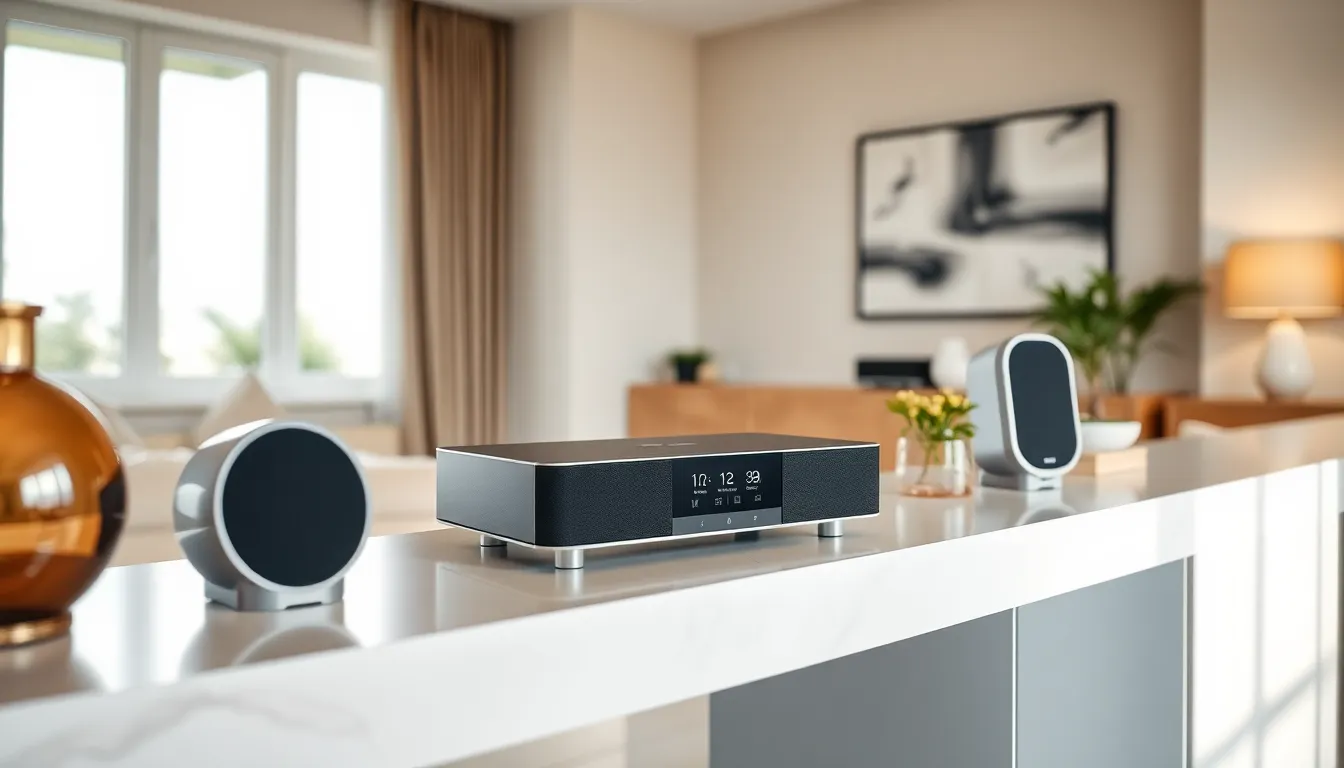In today’s digital world, audio streaming devices have transformed how people experience music and podcasts. These compact gadgets connect effortlessly to Wi-Fi networks, allowing users to access vast libraries of audio content at their fingertips. With a variety of options available, from smart speakers to portable streaming players, finding the right device can elevate any listening experience.
As streaming services gain popularity, understanding the features and benefits of different audio streaming devices becomes essential. Whether it’s enjoying high-fidelity sound in a home theater or taking tunes on the go, these devices cater to diverse preferences. The right choice can enhance daily routines, making it easier to enjoy favorite tracks or discover new artists.
Table of Contents
ToggleOverview of Audio Streaming Devices
Audio streaming devices play a crucial role in delivering music and podcasts effortlessly. These devices range from standalone speakers to smart home systems, all designed for seamless connectivity and expansive audio libraries. Users can enjoy content from services like Spotify, Apple Music, and Tidal through simple Wi-Fi connections.
Key features of audio streaming devices include:
- Versatility: Devices support various audio formats, enabling playback from multiple sources, including smartphones, tablets, and computers.
- Sound Quality: High-resolution audio support enhances audio fidelity, appealing to audiophiles who prioritize rich sound.
- User Interface: Touchscreens and intuitive apps allow users to navigate through playlists and audio settings easily.
- Voice Control: Integration with virtual assistants like Alexa and Google Assistant simplifies voice commands for hands-free operation.
- Portability: Some models, like portable wireless speakers, offer battery-powered options, allowing users to enjoy music on the go.
Brands such as Sonos, Amazon, and Google showcase diverse options for different preferences. Sonos devices excel in multi-room audio setups, while Amazon Echo and Google Nest provide smart features beyond streaming, such as home automation.
Understanding these features helps users select the ideal audio streaming device that complements their listening habits and environments.
Key Features to Consider

Audio streaming devices offer various features that enhance the listening experience. Here are essential aspects to evaluate when selecting a device.
Sound Quality
Sound quality plays a crucial role in audio devices. High-resolution audio support ensures clarity and richness in sound playback. Many devices offer advanced capabilities like lossless audio streaming. Consider models with high-fidelity DACs (Digital-to-Analog Converters) to improve overall sound output, especially for audiophiles. Brands known for superior sound quality include Sonos and Bose, which deliver an immersive experience.
Connectivity Options
Connectivity options determine how easily devices interact with other technology. Look for Wi-Fi connectivity for stable audio streaming without interruptions. Bluetooth capabilities allow for quick connections to smartphones and tablets. Some devices also support multi-room audio setups, configuring multiple speakers for synchronized playback across different locations. Brands like Amazon and Google provide comprehensive solutions with smart home integration.
User Interface and Experience
User interface and experience significantly impact device usability. An intuitive interface simplifies navigation, making it easy to access audio content. Voice control integration with virtual assistants enhances convenience for hands-free operation. Devices with mobile apps provide additional features like personalized playlists and equalization settings. Choices with attractive designs and compact sizes often blend seamlessly into home decor.
Popular Audio Streaming Devices
Audio streaming devices provide a variety of features catering to different listening preferences. Here’s a look at three popular devices and their standout characteristics.
Device 1: Sonos One – Features and Performance
Sonos One excels in delivering high-quality sound with robust bass and clear highs. It supports multiple streaming services, including Spotify and Apple Music, and offers voice control via Amazon Alexa and Google Assistant. Sonos One’s multi-room capability allows users to sync sound across various rooms, creating an immersive audio experience. Its sleek design complements home decor, making it both functional and aesthetically pleasing.
Device 2: Amazon Echo – Features and Performance
Amazon Echo offers versatile audio streaming with high-quality sound and smart home integration. It features built-in Alexa for hands-free control, allowing users to play music, control smart devices, or check weather updates. The device supports Bluetooth and Wi-Fi connectivity, making it easy to connect with other audio sources. Echo’s compatibility with numerous music services further enhances its appeal as a central hub for home entertainment.
Device 3: Google Nest Audio – Features and Performance
Google Nest Audio focuses on delivering balanced sound with enhanced vocal clarity, making it ideal for podcasts and music alike. It integrates seamlessly with Google Assistant, allowing users to use voice commands for music playback and smart home control. Nest Audio also supports multi-room setups and pairs easily with other Google devices for an expanded audio experience. Its minimalist design fits well in various environments, promoting both function and style.
Comparison of Audio Streaming Devices
The comparison of audio streaming devices centers on key aspects such as price range and performance metrics. Understanding these factors helps consumers make informed choices.
Price Range
Audio streaming devices vary significantly in price, catering to different budgets. Entry-level devices typically range from $50 to $150, providing basic functionality and app support. Mid-range options, priced between $150 to $300, often offer better sound quality and additional features, such as multi-room setups. High-end devices, exceeding $300, deliver superior audio performance, advanced connectivity options, and premium materials for enhanced durability. Here’s a breakdown of price ranges for popular devices:
| Device | Price Range |
|---|---|
| Sonos One | $199 |
| Amazon Echo | $99 – $249 |
| Google Nest Audio | $99 |
| High-End Devices | $300 and above |
Performance Metrics
Performance metrics play a vital role in evaluating audio streaming devices. Sound quality, measured in terms of frequency response and total harmonic distortion, indicates how devices reproduce audio accurately. High-resolution audio support enhances listening experiences for audiophiles. Connectivity options, such as Wi-Fi and Bluetooth, define a device’s interoperability with other gadgets. Latency rates influence real-time performance, especially for streaming applications.
Here are important performance metrics to consider:
| Metric | Ideal Range |
|---|---|
| Frequency Response | 20 Hz – 20 kHz |
| Total Harmonic Distortion | <1% |
| Latency | <100 ms |
| Supported Audio Formats | FLAC, ALAC, MP3 |
Understanding these price ranges and performance metrics provides clarity, helping users choose the best audio streaming device for their specific needs.
Audio streaming devices have transformed the way individuals experience music and podcasts. With a variety of options available, users can find a device that suits their unique preferences and lifestyle. Whether prioritizing sound quality, portability, or smart home integration, there’s something for everyone.
As technology continues to evolve, these devices are likely to become even more sophisticated, enhancing the listening experience further. By understanding the key features and performance metrics, consumers can confidently choose the right audio streaming device that aligns with their needs. Embracing these innovations not only elevates daily routines but also enriches the overall enjoyment of audio content.






